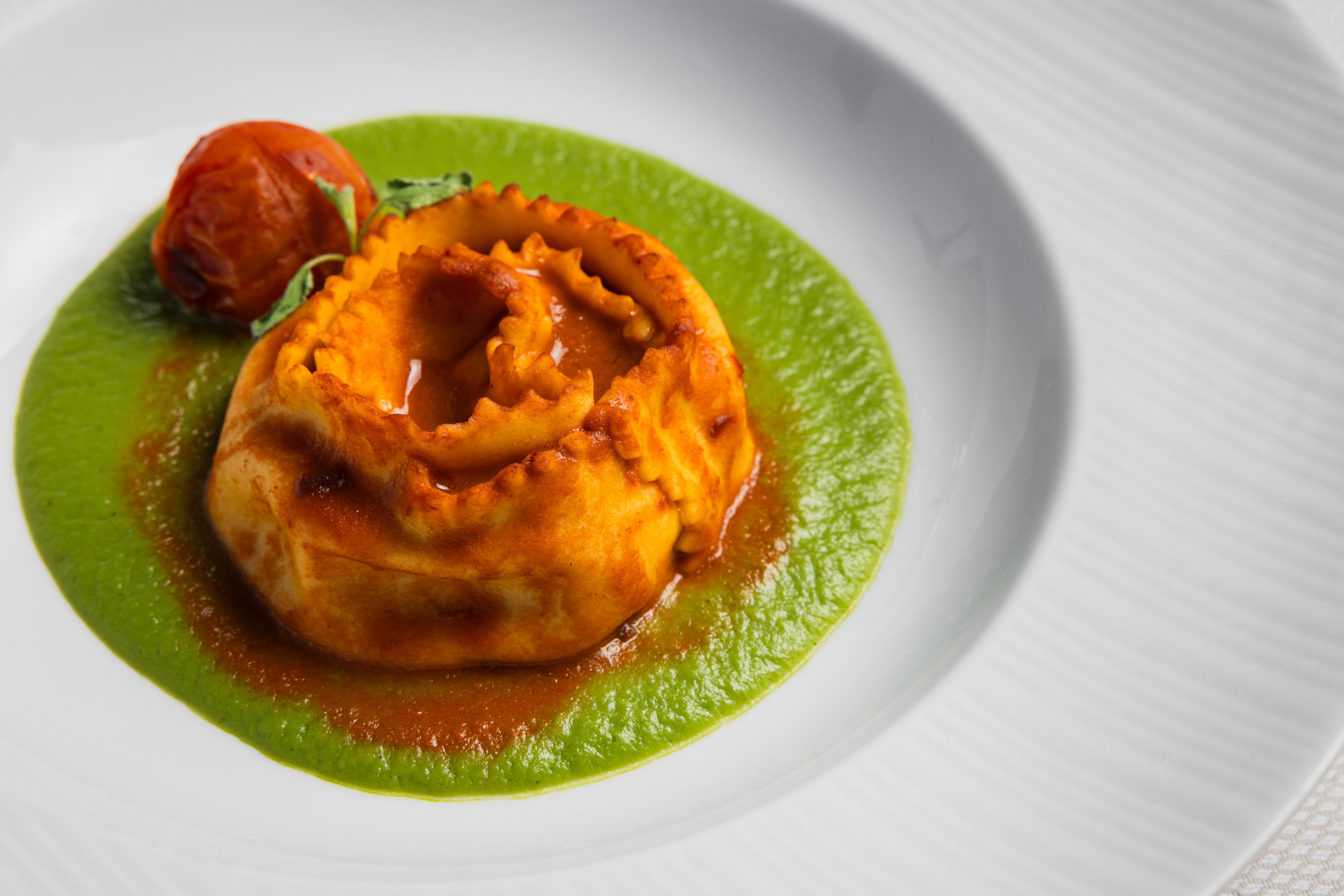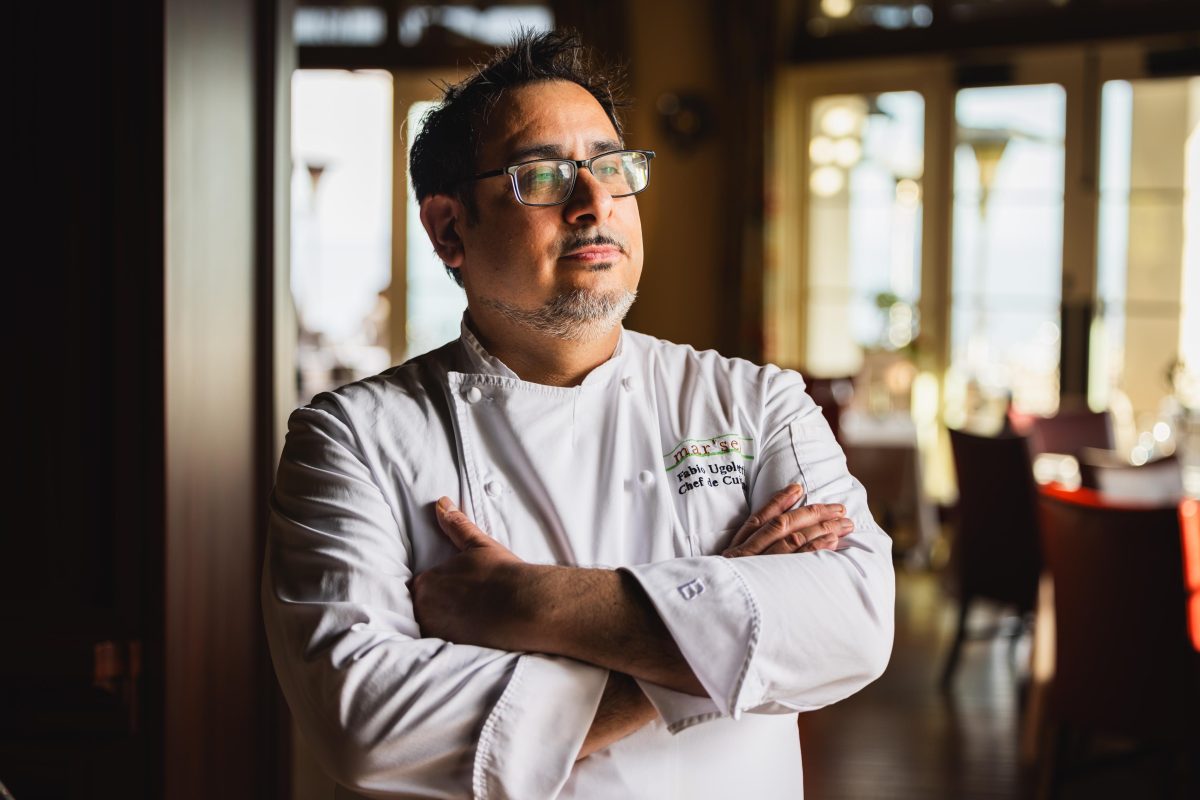by Richard Foss
One of the delights of dining out is ordering something you can’t possibly make at home because of the complexity of the recipe, special skills required of a chef, or the arcane ingredients. This is the nature of special occasion dining, of treating yourself and your dining companions to something different and wonderful. That’s true whether it’s ingredient-focused like a tomahawk ribeye cooked by a master, an omakase sushi splurge, or something involving cutting edge contemporary ideas.
Under Chef Fabio Ugoletti, Mar’Sel is definitely in the final category, and that’s surprising when you know his background. Ugolettii cooked food of his native Italy at traditional restaurants in Los Angeles for eight years. When I interviewed him two years ago, he reveled in the fact he was now free to draw from more global influences. There was a notable Italian influence in his food then, but also Asian techniques and dishes that were impossible to assign to any particular tradition. When I visited again this week, it was obvious that he is still deeply in love with modern post-cultural ideas, but hasn’t forgotten his roots.
The restaurant is still not on the radar of many locals due to its location — it’s down a winding path on the grounds of the Terranea Resort, which itself is on a peninsula of the peninsula. The restaurant is one of the more formal environments in the South Bay, a lovely room with windows to the dining terrace and the sea, with a dark and romantic ambiance after nightfall. It’s a contrast to the louder, brighter ambiance that is typical at restaurants that feature creative cooking.

And it is creative, even a bit overwhelming, to read this menu. You find yourself wondering how a parmesan-vanilla fondue would complement an asparagus salad, why a butternut squash soup with Iberico pork and crisp sage would be enhanced by crumbled amaretto cookies, and whether the espresso demi-glace on the lamb chop will harmonize with the spiced carrot coulis. You spend time imagining flavor combinations you’ve never experienced before, a process that whets your appetite while also leaving you a bit confused about what to actually order. We puzzled over our choices, peppered the waiter with questions, and mused over our choices while nibbling an amuse bouche of asparagus coulis, sweet corn, and mint.
My dining companion and I chose to start with a plate of beef carpaccio with crab aioli, chopped fresh oyster, both parsley and black garlic sauces, pickled onion, finger lime, and watercress. The traditional accompaniments to carpaccio are a drizzle of olive oil, a squeeze of lemon, and perhaps some capers and parmesan, all designed to subtly complement quality raw meat. In this dish the beef was still at the center of the flavor, cool and meaty as cow sashimi can be, but complemented by the mildly citric lime, fresh crab with a dash of mayo, herbal persillade (think pesto made with parsley and you’re not far off), and other elements. We ate in small forkfuls to enjoy the procession of flavors longer, because there were so many things going on, all of them harmonious. It was a wonder of a dish and a fine way to start the meal.
The next item, a cauliflower and white chocolate soup, included shaved cauliflower florets and was topped with crisped enoki mushroom and toasted cashews, then drizzled with leek oil. I have never been a big fan of white chocolate, a mix of of sugar, milk, and cocoa butter — by itself it’s fatty, sugary and floral, and might be compared to kissing someone on the cheek after they’ve slathered on tanning oil. That richness, sweetness, and aroma works in this preparation as a complement to the pureed cauliflower, thanks to the contrasting leek oil and toasted flavors. It’s nicely balanced and an enjoyable novelty, fun and unexpected.
We asked our server for pairing recommendations from the by-the-glass list, and he suggested a Grgich Hills Fume Blanc and a Nozzole Chianti. He had mentioned that the red wine was the better choice for the soup, the white with the carpaccio, and though that may seem counter-intuitive, it was true.

The main courses we chose had at least a nodding acquaintance with Italian traditions, but with distinctive details. I had been puzzled by the reference to pappardelle stuffed with lobster. Pappardelle is a thin egg pasta shaped like a wide ribbon, not something that is usually filled. Chef Fabio lays the pasta out, puts delicately seasoned lobster inside and seals the edges, and then curls it into something that looks like a rosette. This is topped with a tomato sauce, which isn’t particularly unusual, and served over a fresh pea coulis, which is. The sweetness of the peas is moderated by a judicious amount of mint in the sauce, making this a light, fresh entrée.
The other main course was a coppa steak of Iberico pork — a chunk of meat from the shoulder of an ancient Spanish breed of pig that lives on a diet of acorns. Iberico is called “the wagyu of pork” with some justification because it’s a heritage breed noted for tender, sweet meat. The steak had been marinated in soy and tamarind, which added flavor as well as acidity that further tenderized the meat, and had been crusted with ‘nduja, the spicy Calabrian meat spread. I would not have thought of adding rich, fatty ‘nduja to something that already has the silky texture of Iberico, but it worked. It was a steak to be savored in small bites, preferably with a scoop of the accompanying white beans and the underlying pool of salsa verde. (Note this is not a Mexican salsa verde, but an Italian salsa verde — finely chopped parsley, capers, garlic, salt, and pepper with lemon, a dash of red pepper, and a generous amount of olive oil.) It’s a set of fresh, bright flavors that enliven rich, fatty dishes, and a well-chosen accompaniment to this dish.

We finished our meal by sharing what was described as a pear mille-feuille, but had very little in common with the pastry by that name. Mille-feuille (thousand layers) is usually like a Napoleon, a tower of flaky pastry sheets interspersed with multiple portions of heavy cream and other sweet ingredients. This was a cylinder of pastry with a single layer of chocolate cream in the middle, surrounded by artfully arranged thin slices of bosc pear, with a rosette of chocolate cream on top, more pear to crown it, and some crumbled candied nuts on the side. It wasn’t a mille-feuille by the conventional definition, but I’m not sure what else I’d call it, It was delightful.
Dinner at Mar’Sel is a rarefied experience, with a knowledgeable and attentive but not smothering staff adding to the genteel character. Expect to spend at least $175 per person with two glasses of wine each and you won’t be far wrong. For that you get a fine meal in a serene atmosphere. If afterwards, you decide to stroll around the manicured grounds, you’ll probably see other dines in the moonlight. It’s nice to hold onto the feeling of contentment and well-being as long as you can.
Mar’Sel is on the grounds at Terranea Resort, 100 Terranea Way, Rancho Palos Verdes. Open Mon — Sat 5 to9 p.m., Sun brunch 10 a.m. – 2 p.m. Valet parking or parking lot. Weelchair access good. Full bar, ocean view patio. (844) 242-0967. Terranea.com/dining/marsel. Pen










